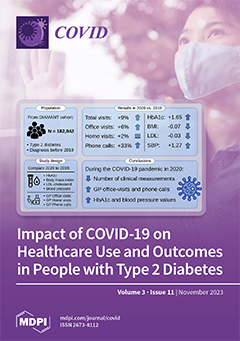Open AccessArticle
Prevalence of Post COVID-19 Condition among Healthcare Workers: Self-Reported Online Survey in Four African Countries, December 2021–January 2022
by
Hager Elnadi, Ahmad I. Al-Mustapha, Ismail A. Odetokun, AbdulAzeez Adeyemi Anjorin, Rasha Mosbah, Folorunso O. Fasina, Youssef Razouqi, Kwame Sherrif Awiagah, Jean Baptiste Nyandwi, Zuhal E. Mhgoob, George Gachara, Mohamed Farah Yusuf Mohamud, Bamu F. Damaris, Aala Mohamed Osman Maisara and Mona Radwan
Cited by 5 | Viewed by 3331
Abstract
The impact of Post COVID-19 Condition (PCC) is ongoing despite the declaration that the 2019 COVID-19 pandemic has ended. In this study, we explore the prevalence of PCC among healthcare workers (HCWs) in four African Countries and its influence on their professional performance.
[...] Read more.
The impact of Post COVID-19 Condition (PCC) is ongoing despite the declaration that the 2019 COVID-19 pandemic has ended. In this study, we explore the prevalence of PCC among healthcare workers (HCWs) in four African Countries and its influence on their professional performance. This study was conducted as an online cross-sectional survey of healthcare workers from four African countries (Cameroon, Egypt, Nigeria, and Somalia) between the 20th of December 2021 to 12th of January 2022. We determined the prevalence of PCC based on the WHO case definition and assessed variables associated with a higher prevalence of PCC in these countries using univariable and multivariable logistic regression analyses. A total of 706 HCWs from four African countries were included in this survey. Most of the HCWs were aged between 18–34 years (75.8%, n = 535). Our findings showed that 19.5% (n = 138) of the HCWs had tested positive for SARS-CoV-2. However, 8.4% (n = 59) were symptomatic for COVID-19 but tested negative or were never tested. Two-thirds of the HCWs (66.4%, n = 469) have received a COVID-19 vaccine and 80.6% (n = 378) of those vaccinated had been fully vaccinated. The self-reported awareness rate of PCC among the HCWs was 16.1% (n = 114/706) whereas the awareness rate of PCC among COVID-19-positive HCWs was 55.3% (n = 109/197). The prevalence of PCC among HCWs was 58.8% (n = 116). These changes include the self-reported symptoms of PCC which included headache (58.4%, n = 115), fatigue (58.8%, n = 116), and muscle pain (39.6%, n = 78). Similarly, 30% (n = 59) and 20.8% (n = 41) of the HCWs reported the loss of smell and loss of taste long after their COVID-19 infection, respectively. Some HCWs (42%, n = 83) believed that their work performance has been affected by their ongoing symptoms of PCC. There was no significant difference in the prevalence of PCC among the vaccinated and unvaccinated HCWs (
p > 0.05). Of the socio-demographic variables, age (older HCWs between 45–54 years; OR:1.7; 95% CI: 1.06, 10.59;
p = 0.001) and location (Egypt; OR:14.57; 95% CI: 2.62, 26.76;
p = 0.001) were more likely to have experienced PCC than other age groups and countries respectively. The study revealed a low prevalence of PCC among the surveyed HCWs. In addition, it observed the need for adequate medical and psychological support to HCWs with PCC and improved mass advocacy campaigns on PCC.
Full article
►▼
Show Figures





